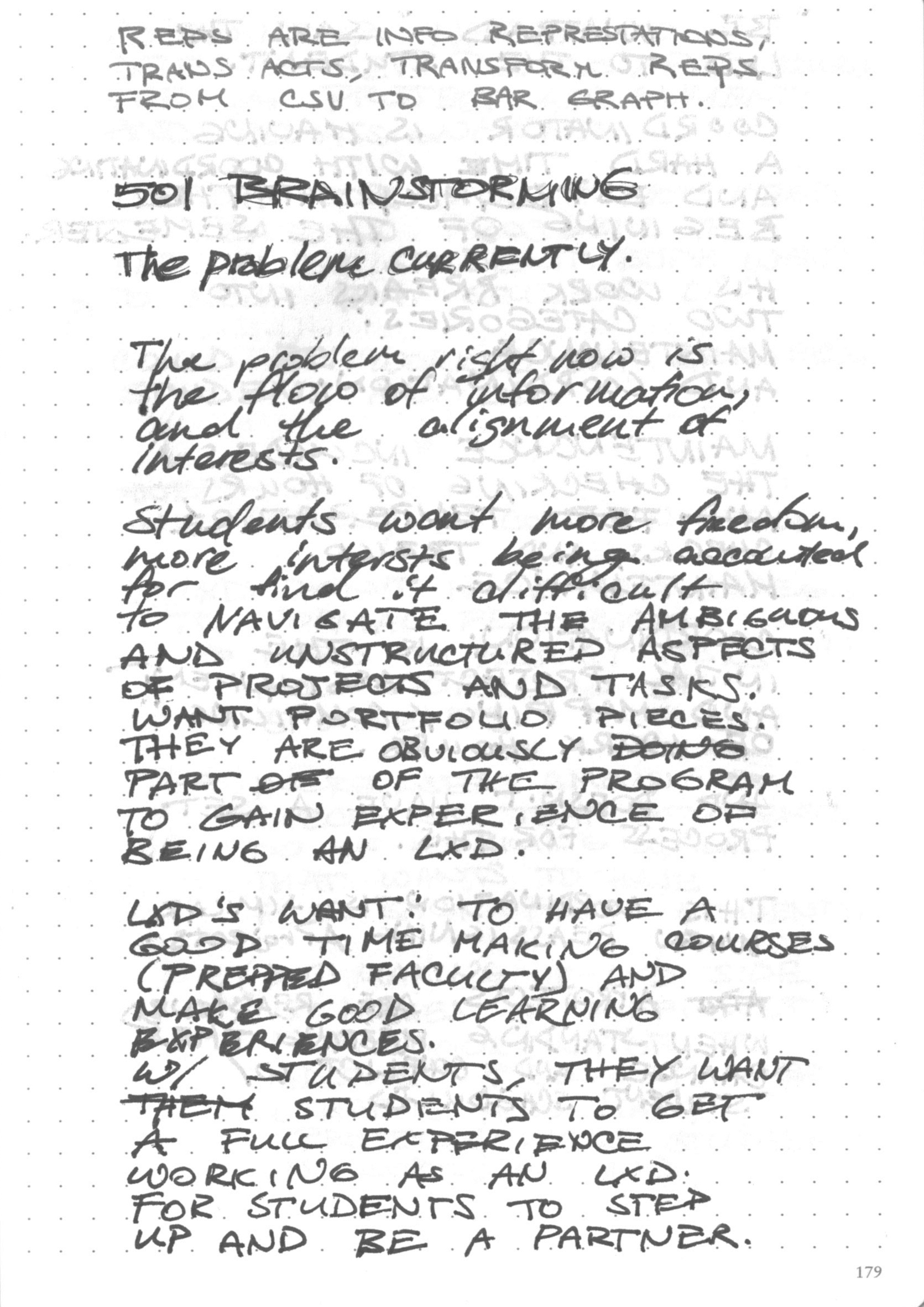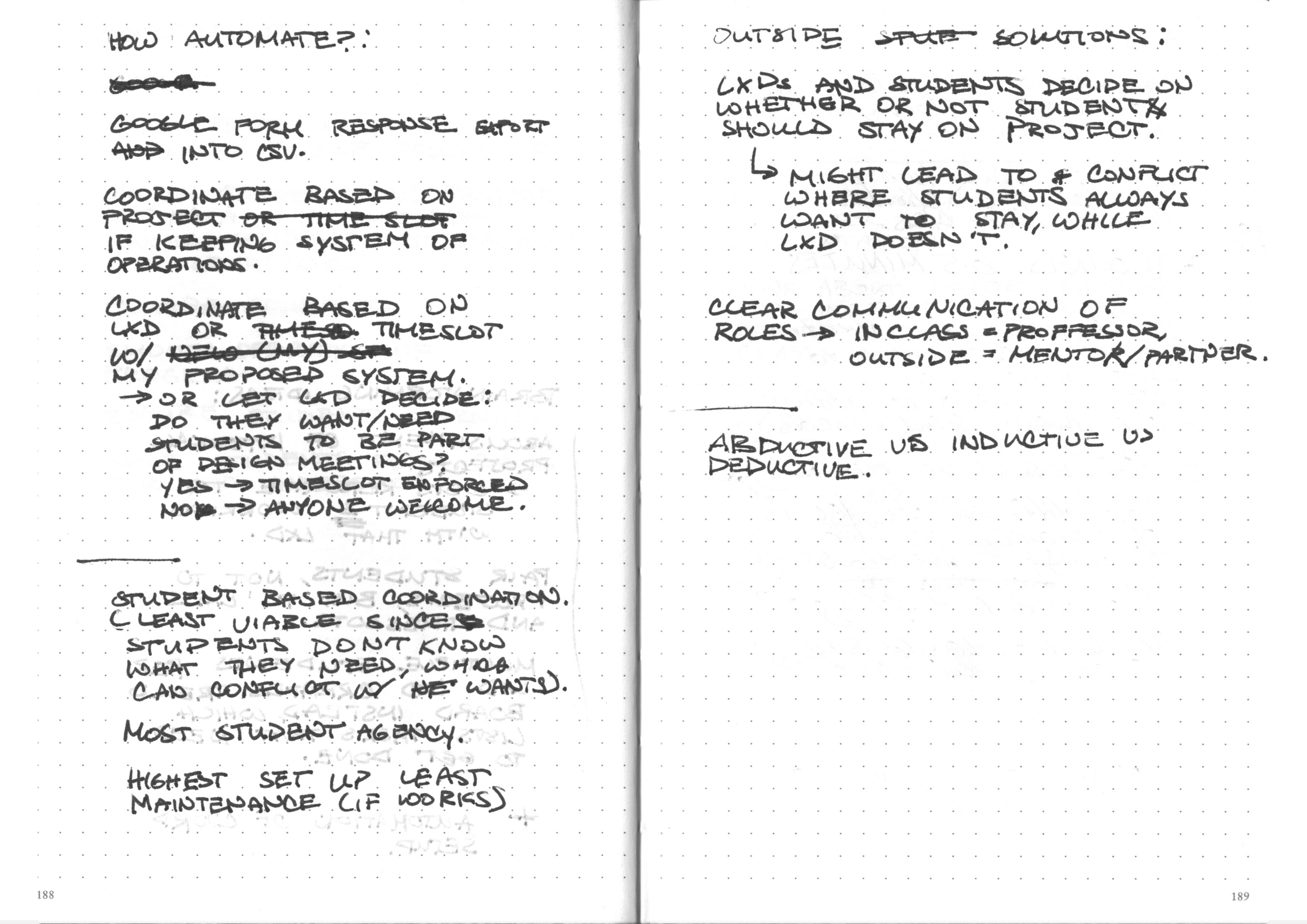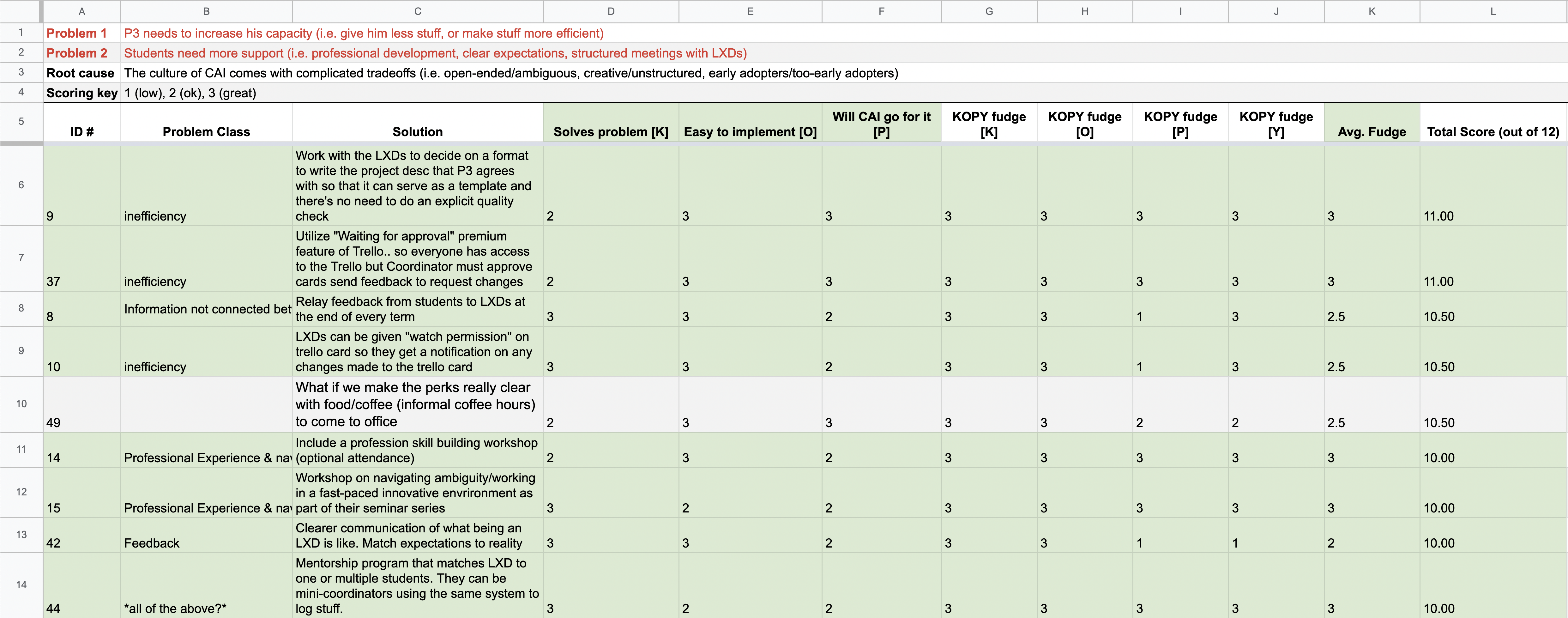
Center for Academic Innovation
Client
- Center for Academic Innovation
- August - December 2021
- University of Michigan
My Roles
- Stakeholder Experience Researcher and Designer
- Client Leadership Relations and Outreach
- Research Methodology Designer
- Editor – deliverables
- Graphic Designer
Context and Client Problem Statement
The Learning Experience Design Graduate(LxD) Certificate Program, offered through Center of Academic Innovation (CAI) provides students with the theoretical understanding and real-world experience required to design holistic student-centered learning experiences across modalities of instruction.
Due to the recent and rapid expansion of the program, the program administrators engaged underscorestudio (a team of MSI students at the University of Michigan’s School of Information) to identify new processes to:
-
Effectively and efficiently coordinate students with projects that best suit their individual learning goals, needs and interests
-
Consistently insipire higher levels student engagement and satisfaction
Key Insights
-
The coordinator is at the center of the workflow and has many responsibilities leading to the break down of communication and the redundancy of several processes.
-
Students’ ability to navigate ambiguity in tasks or deal with power dynamics in a workplace varies based on different levels of students’ professional experiences and backgrounds.
-
Manual and redundant processes are causing bottlenecks in the program’s workflow. They are also not scalable.
-
The alignment of the residency program’s learning goals and student expectations is not clearly articulated leading to a mismatch with student expectations. It should be clearly articulated that the tasks in the residency program are meant to paint a realistic picture of being a learning experience designer.
Final Recommendations
-
Implement mentorship system
The implementation of a mentorship program aims at improving and encouraging student engagement by providing students with much needed support, by circumventing communication inefficiencies, and by simplifying the coordination process.
By working with mentors, students have a place to go to elicit help for difficulties they are experiencing at an individual level—areas might not be well covered-by or suited- for seminar. This includes the refinement of their personal processes and methodology towards designing learning experiences and the deliverables that this entails, however, this can also include working on developing the “intangibles”: the soft-skills required to be a successful learning experience designer and the navigation of the ambiguity and openness inherent to this field of work.
Context: this was a recommendation I arrived at during the individual processing time within a larger group brainstorming session, so, for this recommendation, I am able to and will talk about my personal thought processes.
When I looked at the key findings, I was trying to find a way to piece everything together, and I realized that the four findings could further be distilled into:
-
Both the overburdening of the coordinator and the redundancies of the system were due to the centrality of the coordinator within most processes
-
Student dissatisfation and lack engagment was mainly due to uncertainty: students were not properly made aware of the value in the more menial projects, and, with the larger higher impact projects, students experienced difficulties navigating the ambiguity inherent to the designing of learning experiences
This lead me to look for a holistic solution that would better support students while/by unburdening the coordinator and steamlining the communicaiton & coordination processes.
See my notepad and thought process in the brainstorming section.
-
-
Delegation, automation, and simplification.
The current program-coordination process and student-project management process, is almost entirely done by hand. Due to the programs rapid expansion and continued projected expansion, this model is no longer sustainable, and it is therefore essential to redistribute responsibilities and automate or simplify (cull) redundant processes and tasks.
-
Improve Student and Learning Experience Designer (LxD) Experience
The management of the program is focused on the growth, development, and maturation of the program. This, however, was seen as synonymous with providing a well designed learning and teaching experience for students and LxDs respectively, leading to misdirected efforts. To better engage students in their learning and support LxDs in their training of students, it is vital to realign the program’s focus onto the experience of the students and LxDs.
-
Using Google Calendar to visualize student-project mapping
In order to account for the interests and background of the students, the program conducts the pairing of students to LxDes projects by hand. There is, however, no set process or designated artefacts to help, which has resulted in a highly inefficient, inconsistent, and “chaotic” process.
Since a large portion of the pairing process is in the balancing of schedules, the utilization and “hacking” of Google’s Calendar provides a short-term (not scalable) fix that streamlines and automates much of the process.
Client Feedback
"The immediate benefits of your work will improve our working conditions at CAI, the longer term benefits of this project will surely be felt among cohorts."
"A particular highlight from your report was the recommendations section, when you weighed multiple solutions for one problem next to each other. This was most appreciated... you presented multiple solutions for us to consider, and gave us a fair assessment of their scalability and impact on student experience."
"In a pedagogical sense, we think this presentation tact helps us “get into the design mindset” and approach the written material as co-contributors to the solution engineering process. Thank you for your detail-oriented work in this regard."
"Overall we found the experience compelling, rewarding, and a benefit to our team and the residency student experience."
—CAI Leadership
Research
Research Goals
-
Identify and understand the factors that negatively impact student engagement
-
Understand the concurrent student-project assignment process and its effects on student engagement
-
Understand the student coordination process within projects and its effects on both student engagement as well as the student-project assignment process.
Methodology and Process
After meeeting with the program's leadership to understand scope of issues and the concurrent program system and status, I co-lead and designed the research methodolgy and defined the overarching hunt statement and research goal as well as the the research goals for each of the primary stakeholder groups.
This approach optimizes for both width and depth in research and allowed us to indentify the root causes of the issues regarding student engagement and student coordination.
-
Leadership Meetings
We met with leadership to understand scope of issues and the concurrent program system and status.
-
Background Research
To better understand the problem space and inform our reach approach, each team member also conducted individual background research in the form on literature analysis. Our compiled research reports total over 8000 words.
I researched Massive Online Open Courses (MOOCs) and the differences between designing online-courses and in-person courses, and my report can be read here: Designing the Bits and Bytes of Online Course Design.
-
Contextual Inquiry and Semi-Structured Interviews
We conducted 7 semi-structured interviews, site-visits, and gathered & analyzed artefacts. I lead 2 interviews and took notes for another 2.
-
Participants per stakeholder group:
- Learning Experience Designers x3
- Associate Director x1
- Program Coordinator x1
- Student x1
Synthesis
We analyzed the qualitative data through affinity diagramming and workflow & system modeling


Ideation & Evaluation
Brainstorming




Altogether, our team held three separate brainstorming sessions that were split between individual and group brainstorming, during which ideas would often be combined into proto-solutions.
After we had generated 50 proto-solutions, we compiled them into a spreadsheet and rated and ranked each based on its ease-of-implementation, the importance of problem(s) it aimed address, and the likely extent to which it solves these problems.

Reflections
Team Dynamics
In order to ensure deliverables made all the deadlines
and without loss of quality, I really had to utilize my role as the person that finalized everything to connect and
work with each team member individually. I also had to really lean into my individual relationship and rapport with each
member to keep the project on track and keep the communication consistent. Thankfully, everything held through the very
end, and the team ultimately delivered a great final presentation and report to both the class and the client.
Looking back, if I could repeat, I would definitely much more emphasis into building the team dynamic rather than
holding things together by working with teammates individually. This isn’t to say that this new approach is
definitively better, especially when given the circumstances and my personal bandwidth, but I think that it’s
important to learn how to help teammates connect with each other.
ciao~